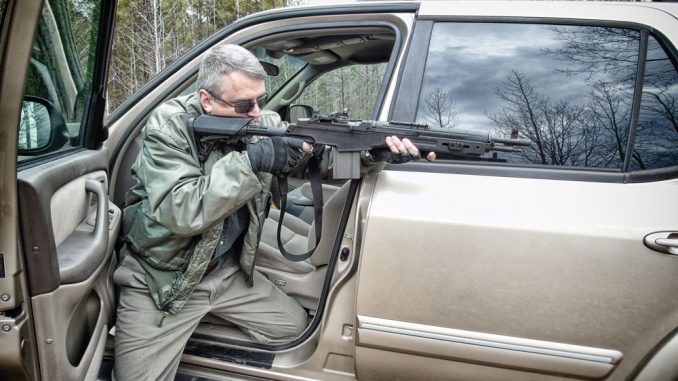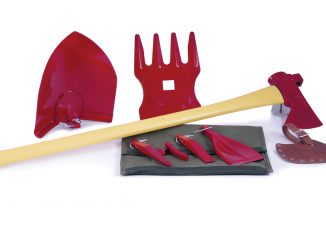
I like punching concentric holes at ridiculous distances just as much as the next gun nerd. However, there is really no imaginable circumstance wherein we might be called upon to do that for real.
No matter the situation, in a genuine survival scenario, you will be shooting up close or not at all.
NO MATTER THE SITUATION, IN A GENUINE SURVIVAL SCENARIO, YOU WILL BE SHOOTING UP CLOSE OR NOT AT ALL.
The M16 and its progeny have served U.S. forces in combat longer than any other military rifle in American history. When it was initially introduced, the M193 5.56 x 45mm round was derided as a “poodle-shooter” not worthy of utilization in real-world combat.

Alas, we have found out after literally decades of gritty combat experience that the 5.56mm is, indeed, adequate for its intended applications. However, the 5.56 prevails not because of its breathtaking effectiveness, but rather because it is easy to carry and even easier to shoot.
For those times you need to punch a little bit deeper without sacrificing maneuverability, Springfield Armory offers the M1A SOCOM 16 CQB.
Origins
The Springfield Armory had its beginnings in 1777 as a place to store artillery pieces and gun carriages that our newly minted nation might need to prevail in the face of myriad existential threats. George Washington signed the original charter.
Over the centuries, America’s armory served as a national repository, safeguarding the science and engineering required to produce cutting-edge small arms. In the tumultuous 1960s, the Springfield Armory got axed as part of budget cuts and was no more.

The nasty end of the M1A SOCOM 16 CQB has had a total facelift. The front sight incorporates a tritium insert, and the stubby muzzle brake siphons a great deal of the recoil out of the gun.
In 1974, the Springfield Armory name became a private holding. The Reese family set out to resurrect the Springfield Armory to its former greatness as a provider of quality firearms to America’s civilian shooters. Those first few early offerings included the M1 Garand, the M1A (a civilianized semiautomatic version of the selective-fire M14 service rifle) and the classic 1911 handgun.

The safety on the M1A SOCOM 16 CQB is an ambidextrous pivoting tab in the front aspect of the trigger guard.
In recent years, Springfield Armory has expanded into polymer-framed pistols, as well as modern sporting rifles. The good folks at Springfield Armory have also seen fit to modernize the classic M1A. The newest variation is designed specifically for the close fight and is called the M1A SOCOM 16 CQB.

This angle provides a better view of the tritium insert on the front sight.
Modern Special Operators have long seen the need for a compact, authoritative .30-caliber battle rifle that could project power beyond what 5.56mm weapons might address. Nowadays, the SCAR 16, HK 417 and various modernized AR10 variants fill this need. Back when I wore the uniform two decades ago, this meant customized M14 rifles brought out of mothballs and put into service once again. Today’s Springfield Armory M1A SOCOM 16 CQB is arguably the toughest of the lot.
Heritage
The M14 emerged from a murky competition to engineer a replacement for the venerable M1 Garand in the aftermath of World War II. The M1 had served with distinction in all theaters of war, but those few long years of combat had utterly transformed the tools with which infantrymen conducted battle. Seeing the Garand growing rapidly long in the tooth, the U.S. Army pushed forward for something new with which to face down the Soviets, our erstwhile allies in that most recent conflict.

There is a nice scope mount rigidly affixed to the near end of the barrel. This is the perfect spot for a long eye relief optic or an EOTech Holosight.
The Germans, in their thoroughly defeated state, had actually been the impetus behind a cosmic shift in small-arms design. Most of the world’s militaries had entered World War II wielding the weapons with which they fought during World War I. However, the Germans ultimately appreciated the unnecessary excess behind equipping all of its troops with rifles capable of remaining lethal out beyond a kilometer. In response to new trends in mobile warfare, the Germans contrived the 7.92 x 33mm Kurz intermediate round and the radical StG44 Storm Gun to fire it. This selective-fire meat grinder left a deep impression on the American and British dogfaces who encountered it in combat.

The indestructible polymer chassis is from Archangel. There are five positions for the buttstock component, and the cheek riser is adjustable.
While the entire planet seemed to be transitioning to smaller, lighter intermediate rounds, we Americans clung dogmatically to our full-power rifles. We were then a nation of riflemen; and, despite compelling evidence, we simply failed to embrace the well-trod path. Our new 7.62 x 51mm cartridge was incrementally smaller and lighter than the World War II-era 7.62 x 63mm .30-06 … but not by much. What we got for that tactical intransigence, however, was an immensely powerful combat rifle.
MODERN SPECIAL OPERATORS HAVE LONG SEEN THE NEED FOR A COMPACT, AUTHORITATIVE .30-CALIBER BATTLE RIFLE THAT COULD PROJECT POWER BEYOND WHAT 5.56MM WEAPONS MIGHT ADDRESS.
In 1952 and ’53, several new rifle designs battled for supremacy to determine the Army’s replacement for the M1 Garand. The prototype M14 was the T44. The counterpart derived from the FN FAL was the T48. While the T48 was deemed superior in most respects, the T44 was found to be more reliable under arctic conditions while remaining a full pound lighter. The T44 was subsequently polished into the M14 that served as the standard American service rifle from 1959 until it was supplanted by the M16 in 1964.
Information Age Upgrades
The Springfield Armory M1A SOCOM 16 CQB retains all that is righteous and holy about the M14 while supercharging the gun for close-quarters use. The forged steel receiver and detachable box magazine remain the same, while the 22-inch barrel gets pruned back to 16.25 inches. Interestingly, losing half a foot off the barrel only costs about 50 feet per second at the muzzle. The previous long, slotted flash suppressor got sacked in favor of a stubby muzzle brake.
THE SPRINGFIELD ARMORY M1A SOCOM 16 CQB RETAINS ALL THAT IS RIGHTEOUS AND HOLY ABOUT THE M14 WHILE SUPERCHARGING THE GUN FOR CLOSE-QUARTERS USE.
The fire control system remains the same as that which drove the M1 Garand. The front sight now includes a tritium insert, while the rear sight is an easily adjustable, wide-aperture ghost ring peep. My gun came standard with a Vortex Venom micro-red-dot sight, as well. There is no provision for a bayonet, and the muzzle anatomy is such that the gun will not readily accept a sound suppressor.

The author’s M1A SOCOM 16 CQB came with a Vortex Venom micro-red-dot sight mounted atop the stripper clip guide. This tiny sight points the gun quickly with no significant weight or bulk penalty.
The classic oiled walnut furniture has been replaced with a modern polymer chassis from Archangel Manufacturing. This high-tech stock incorporates a sliding buttstock component with five detent positions, as well as an adjustable cheek riser. The stock comes with one seven-slot and two three-slot M-LOK rails for accessories. The new SOCOM 2 offers a more extensive external railed aluminum chassis, but I have found my SOCOM CQB to have plenty of railed real estate.

Certain applications demand a bit more power than might be coaxed from the diminutive 5.56mm round. The M1A SOCOM 16 CQB offers .30-caliber power in a compact, maneuverable chassis.
The magazine well is fortified and flared slightly for rapid magazine changes. However, this extra material precludes the use of an X-Products 50-round drum. SOCOM models with more-conventional furniture will still accept the drum.

There are three M-LOK rails that come with the gun. These accessory rails are perfectly scaled to accept a quality compact illuminator such as this Streamlight TLR-1 HL. The TLR-1 HL snaps easily on and off, and the controls are thoroughly functional.
There is a mount for the red-dot sight incorporated into the stripper clip guide over the near end of the bolt raceway. There is also a more substantial mount affixed to the barrel forward of the receiver. This mount would be a natural foundation for a long eye relief scout scope or an EOTech Holosight.
Practical Tactical
The manual of arms is identical to that of any other M14-series rifle with which you might be familiar. The safety is a pivoting tab in the front aspect of the trigger guard. With a little practice, it is a simple task to flick this appendage forward with the trigger finger—no matter your handedness. The right-sided charging handle is rigid and reciprocates with the bolt. Right-handed operators must cant the gun and reach across it to jack the bolt, but this is easier to do than to describe. The rigid nature of the charging handle means you can manhandle the gun if things get sticky.
THE SOCOM 16 CQB HANDLES CORNERS AND MANEUVERS WITHIN AND AROUND VEHICLES AS WELL AS YOUR FAVORITE AR MIGHT. HOWEVER, ITS .30-CALIBER CHAMBERING CARRIES FAR MORE DOWNRANGE THUMP.
The magazine catch is also located along the centerline for easy access with the thumb of the weak hand, no matter which paw is dominant. Magazines must be hooked at the front and rocked in place in the manner of a Kalashnikov. While this might take an extra heartbeat in action, it also means that the resulting leverage makes it easy to seat a full magazine against a closed bolt. This can be a serious chore in AR-pattern guns.

The SOCOM 16 CQB is a satisfying blend of maneuverability and firepower.
The bolt automatically locks to the rear after the last round is fired. Swap the magazine by slightly rocking the old one out and a fresh one in. Give the bolt handle a quick snatch to the rear to release it over the new mag. There is a manual latch that can be used to lock the bolt open in the absence of a magazine for either inspection or service.
Basic fieldstripping is straightforward without tools. Disassembly of the gas plug does require a special wrench, but this is included in a GI cleaning kit.
Trigger Time
So, how does she run? She runs really, really fast—and really, really loud. The SOCOM 16 CQB handles corners and maneuvers within and around vehicles as well as your favorite AR might. However, its .30-caliber chambering carries far more downrange thump.
… WITH THE ENTIRE INDUSTRY FROM WHICH TO CHOOSE, IT IS MY M1A SOCOM 16 CQB THAT SITS NEXT TO THE DOOR, READY TO GRAB AND GO.
The proprietary muzzle brake does a great job of taming recoil. Recoil with the SOCOM 16 CQB is really not markedly more abusive than is the case with typical 5.56mm guns. However, all that recoil management comes at the expense of muzzle blast and pure, unfiltered racket. (Did I mention this gun is loud?)

The Springfield Armory M1A SOCOM 16 CQB packs .30-caliber power into a package more typically associated with 5.56mm guns. The resulting weapon maneuvers quickly while retaining all that big-bore downrange thump.
Follow-up shots are as smooth as on any .308 battle rifle I have ever run, despite the gun’s compact geometry. I attribute this to the superlative muzzle brake. With the Vortex Venom red-dot sight in place, the gun swings on target quickly and indexes like your favorite poodle-popper.
What Is It Really Good For?
Should the zombies roll up onto your lawn, mechanized and in vehicles, this is the gun that will take all the ambiguity out of that exchange. The same can be said if they are lurking behind modest cover. .308 ammo is heavier and bulkier than 5.56. That’s why the Army made the swap back in the 1960s in the first place. However, as our boys and girls serving downrange have found out, sometimes, you just need a little more horsepower than the 5.56 can offer. For proper barrier penetration and thoroughly reliable downrange performance, sometimes it just has to be .30-caliber or nothing at all.
The niche that the SOCOM 16 CQB occupies is unique. The gun does what your favorite small-caliber black rifle might do—up close at bad-breath range—with a modest penalty in weight and literally no penalty in length. However, if the threat is tough to reach, the SOCOM 16 CQB punches deep enough to root him out.
After nearly three decades of writing for the gun press, my personal stable is ably stocked. However, with the entire industry from which to choose, it is my M1A SOCOM 16 CQB that sits next to the door, ready to grab and go. I can personally think of no higher accolade.
SOURCES
Springfield Armory
(800) 680-6866
www.Springfield-Armory.com
Federal Ammunition
(800) 379-1732
www.FederalPremium.com
Gorilla Ammunition
(772) 564-0777
www.GorillaAmmo.com
HSM Ammunition
(406) 777-2106
www.TheHuntingShack.com
Streamlight
(800) 523-7488
www.Streamlight.com
Vortex Optics
(800) 426-0048
www.VortexOptics.com
Winchester Ammunition
(618) 258-2900
www.Winchester.com
Vortex Venom Sight
The Vortex Venom is a 3 MOA LED red-dot sight small enough to go most anyplace. Although the Venom is adequately compact to ride atop your favorite combat handgun, it will also render fine service on a tactical rifle. Flush 1 MOA windage and elevation adjustments make zeroing breezy, while the easily accessed, side-mounted controls make for simple brightness adjustments on the fly.
The Venom runs off a CR 1632 button battery, available at any pharmacy. The battery is easily exchanged from the top of the sight, so you need not worry about upsetting your zero.
The Venom is a genuine 1X both-eyes-open sight without distortion or noteworthy parallax. The machined aluminum housing is as robust as your weapon, and the whole rig weighs only 1.1 ounces. The Venom is waterproof and shockproof while offering 10 different brightness levels.
The Venom shuts itself off automatically after 14 hours and offers around 150 hours of operation on a single battery. Lower brightness settings can extend that out to 30,000 hours. For a reasonably priced, reliable and rugged red-dot that will not weigh you down, the Vortex Venom offers all that—and more.
Editor’s note: A version of this article first appeared in the March, 2018 print issue of American Survival Guide.





Be the first to comment